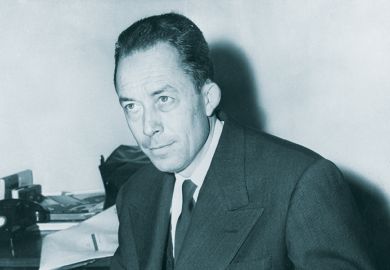A successful popular book on the Dead Sea Scrolls requires the following ingredients: an easily readable story, preferably written by a non-specialist (academics try to be too precise); rebellion against accepted ideas; and a "radical" thesis with the promise of a revolution in our understanding of ancient Judaism and - above all - of Christianity. The Scrolls from the Dead Sea (1955) by the late Edmund Wilson is still the unbeaten champion of this class.
Wilson's charmingly witty portraits of the Qumran pioneers remain a pleasure to read, and even his adventurous claims concerning the primary relevance of the Scrolls to a correct historical perception of Christian origins sound sensible compared to some of the ideas propagated in the last few years.
In 1991, Michael Baigent and Richard Leigh launched the entertaining Dead Sea Scrolls Deception. But, unfortunately, their main thesis, viz that the long delays in publishing the Scrolls were due to a Vatican-inspired conspiracy, fell apart under the impact of events. A few months after the book's launch general access was granted to the Qumran texts, yet more than three years of intense search among the unpublished documents has failed to uncover anything theologically revolutionary in them.
In The Hidden Scrolls, Neal Asher Silberman tries to improve on Wilson and Baigent and Leigh. He updates the Scrolls' story with the help of interviews with a selection of Qumran scholars from the United States and Jerusalem. (The rest of the world does not seem to matter.) His star performers are the chatty John Strugnell of Harvard, the ingloriously deposed chief editor of the Scrolls, the blunt and no less talkative Larry Schiffman of New York University, and above all, the enthusing Californian Robert Eisenman, loved by the media but savaged by scholars, whose attempted rehabilitation is the common aim of The Hidden Scrolls and The Dead Sea Scrolls Deception.
Silberman's book provides a good read, but its value is impaired by an eagerness to hammer home the flimsiness and (though the term is not used) dishonesty of the academic "consensus" (a dirty word) concerning the Essene identity of the Qumran community and the mid-second century bc date assigned to its beginnings.
According to Silberman, the "consensus" theory owes its success to a moral blackmail. The all-powerful official team of Scrolls editors imposed the acceptance of their views as a condition of academic respectability. We won't admit you to our club, they are supposed to have declared, unless you subscribe to our ideas. These "consensus" people have deliberately ignored the omnipresent militancy and revolutionary rage in the Scrolls. They have also failed to notice that these manuscripts echo the rebellious spirit of the great messianic movement of first century ad Palestinian Jewry and that the men of Qumran represent the radical, militant, xenophobic, and bloodthirsty reality of primitive Christianity, discovered by Robert Eisenman.
Silberman does not feel the need to demonstrate these baffling claims. For him, the "consensus" reconstruction of history with remote and eirenic second-century-bc Essenes is patently contrary to the message of the Scrolls, replete - at least according to The Hidden Scrolls - with messianic rage, revolution, xenophobia, visions of an unimaginably bloody war with the Romans and so on.
Yet the official editors and their followers refuse to recognise that Qumran reflects Palestinian life in the first century ad and not in the second century bc.
Well, Silberman's insistence is without foundation. To begin with, messianism is relatively rare at Qumran. The word Messiah is attested only in about two dozen passages. True, the War of the Sons of Light against the Sons of Darkness is rich in military language, but it is not a political pamphlet, but manifestly a theological treatise in which the principal actors are trumpet-blowing priests. The earthly hosts on both sides are mere auxiliaries, the real action is between angels and demons. Even the earthly foe is well-behaved and refuses to exploit the abstention from fighting by the Sons of Light in every seventh or sabbatical year during the 40-year final war.
Noone familiar with the Scrolls should be astonished either by the "consensus" scholars' dating of the conflict between the founder of the sect, the Teacher of Righteousness, and his opponent, the Wicked Priest, to the pre-Roman era (before 63 bc). For, although the texts often mention the Kittim-Romans, they never associate them with the Teacher or the Wicked Priest. The beginning of the sect is placed in the age of "the kings of Greece", ie the Hellenistic era. The Kittim constitute a future menace for the "last priests of Jerusalem".
Nor is it true that the "consensus" theory was devised by the members of the international team. Its main tenets were formulated before the establishment of the team by scholars who were not part of it. As the original proposer of the Maccabaean historical reconstruction, I ought to know. Shortly after my historical interpretation was published in 1952, I met two members of the team in the street in Paris. They found my theory unbelievable. A couple of years later, having examined the arguments adduced, they changed their minds.
Silberman discards palaeography as a pseudo-science and simply ignores radiocarbon dating. Without wishing to speculate about the reason of his silence, I should remind readers that a carbon 14 test was commissioned in 1990 by the Israel Antiquities Authority largely at Eisenman's instigation. The test, performed in Zurich, substantially confirmed the (mostly pre-Christian) dates proposed for the manuscripts by the "consensus" palaeographers. Almost at once, Eisenman declared that carbon dating was still in its infancy and consequently unreliable.
A final word on the notorious "Pierced Messiah" text. In November 1991, Robert Eisenman announced that he had discovered among the unpublished scrolls a small fragment alluding to a "pierced" and executed Jewish leader, similar to Jesus. I immediately set out to show that in the light of the Qumran context this interpretation was untenable.
In recounting the episode, Mr Silberman voices his suspicion that as the recently designated official editor of this text, I may have been motivated by resentment towards Eisenman for stealing my thunder. But a minimum of enquiry would have shown that when my criticism of Eisenman's theory first appeared, the fragment did not "belong" to me, but to John Collins of Chicago, who on reading my article generously invited me to take charge of the text: "Since you've already done the homework, you'd better finish the job." Amateur investigative journalists beware.
Geza Vermes is professor emeritus of Jewish studies, University of Oxford.
The Hidden Scrolls:: Christianity, Judaism, and the War for the Dead Sea Scrolls
Author - Neil Asher Silberman
ISBN - 0 434 70288 9
Publisher - Heinemann
Price - £16.99
Pages - 306pp
Register to continue
Why register?
- Registration is free and only takes a moment
- Once registered, you can read 3 articles a month
- Sign up for our newsletter
Subscribe
Or subscribe for unlimited access to:
- Unlimited access to news, views, insights & reviews
- Digital editions
- Digital access to THE’s university and college rankings analysis
Already registered or a current subscriber? Login



